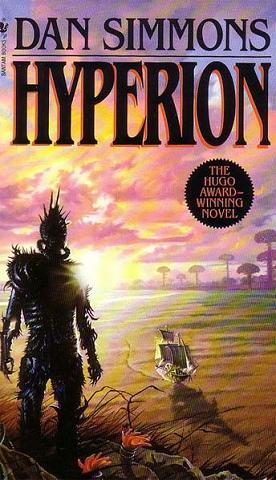It was vaguely man-shaped but in no way human. It stood at least three meters tall. Even when it was at rest, the silvered surface of the thing seemed to shift and flow like mercury suspended in midair. The reddish glow from the crosses etched into the tunnel walls reflected from sharp surfaces and glinted on the curved metal blades protruding from the thing’s forehead, four wrists, oddly jointed elbows, knees, armored back, and thorax. It flowed between the kneeling Bikura, and when it extended four long arms, hands extended but fingers clicking into place like chrome scalpels, I was absurdly reminded of His Holiness on Pacem offering a benediction to the faithful.
I had no doubt that I was looking at the legendary Shrike.
– Dan Simmons in Hyperion

As an avid fan of science-fiction, I’ve read just about all of the classics of the genre. Dan Simmons’ Hyperion is one of the exceptions, so it was with some pleasure that I came across a copy of it while browsing at a bookstore at Warisan Square here in Kota Kinabalu. I’ve already had some familiarity with the plot, having read one or two of Simmons’ short stories based on the same setting in various anthologies, but this was the first time that I’ve actually read the book, and I have to say that it deserves every bit of the many accolades it has been given.
Hyperion is only the first book of Simmons’ Cantos, and the name derives from John Keat’s unfinished poem of the same name. It is set in the far future during which humanity has spread across the galaxy under the united rule of the Hegemony of Man. Earth itself is no more, having being destroyed by a runaway micro black hole long ago, but humanity lives on many hundreds of planets that are connected by farcaster portals that permit instantaneous travel to form the WorldWeb. The Hegemony itself co-exists in a sometimes uneasy partnership with the TechnoCore, an agglomeration of countless numbers of AIs who seceded from humanity but without whom the farcasters and many other examples of advanced technology would be impossible to operate. The primary enemy of the Hegemony are the Ousters, a faction of humanity who left Earth after it was destroyed and continued to live and evolve on their ships, disdaining all contact with the Hegemony and especially the TechnoCore.
For all the technological achievements of the Hegemony however, there are still unresolved mysteries and unknowns that humanity cannot understand, and the greatest of these mysteries are on the planet known as Hyperion, a remote and thinly populated colony world that is unconnected to the WorldWeb and therefore can only be reached by starships. It is there where the Time Tombs stand, huge and seemingly empty structures of unknown origin and purpose, protected from the ravages of time by anti-entropic fields and it is there that the Shrike roams, a demigod of liquid metal with the ability to extrude blades from any part of its body at will and seems to be indestructible and completely invincible. As fearsome as the being is, it has become the object of worship of a cult that spans the Worldweb who call it the Pain Lord and organize regular pilgrimages to it. The legends goes that for every pilgrimage, always composed of a prime number of pilgrims, all save one will either be eviscerated or impaled for all eternity on the Shrike’s Tree of Thorns, and the one survivor is granted a single wish.
The novel tells the story of one last pilgrimage launched just as the long awaited war between the Hegemony and the Ousters begins in the space around Hyperion. As you might expect, each of the pilgrims has a unique and extremely compelling reason to visit the Shrike while everyone else on the planet is clamoring for any available transport to leave it. As the seven travellers make their way across the world to what will undoubtedly be death for most of them, they decide to tell each other their respective stories in order to prepare themselves in whatever small way that they can for the final confrontation.
The most impressive thing about Hyperion is how masterfully Simmons pulls off each of these stories despite each of them being of a different genre. From action-packed military SF, to Lovecraftian horror, to a romance across time and space and a neo-noir detective story, each of them is well written and entertaining and ties the various characters together in a complex overarching plot that stretches back to the beginnings of the Hegemony. The most disappointing aspect is that the novels end after the pilgrims have told each of their tales but just before the final confrontation with the Shrike, so you’ll have to read the next book to find out what happens. I’m certain to do so as soon as I’m able, but I can’t help but hold a sneaking suspicion that after the wonderful build-up in Hyperion, whatever resolution that follows will be a let-down.
Dan Simmons is one of my favorite writers. His versatility writing in many genres is second to his masterful storytelling and tight prose. I highly recommend just about any of his books. “Summer of Night,” “Carrion Comfort,” two of his earlier efforts, are worth checking out, and I really enjoyed “The Crook Factory.”
peace,
mike
livelife365
I Miss My Hair